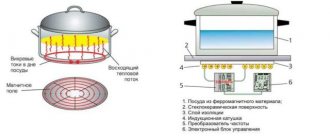How does a microwave oven work?
To repair/maintain any equipment, including a microwave oven, you need to know the principle of its operation. Let's look at the basic elements and their purpose.
Magnetron
At the heart of a microwave oven is a magnetron, which, when turned on, produces microwave energy and distributes it throughout the interior.
The magnetron screen is located inside the microwave on the right behind the wall where the control panel is located. It is made in the form of a cover, which is attached to latches or screws.
The function of the screen is to protect the magnetron from particles of food from the cooking zone.
The device is connected to the camera using a rectangular waveguide, which is covered with a glass or plastic cover.
Power supply
Transformers-stabilizers, which are the most complex and expensive element, act as a power source.
As additional equipment, a multiplier is used, which includes a capacitance and a diode bridge.
After applying voltage to the magnetron, the fan also turns on, which distributes warm air and thereby speeds up the cooking process.
Frame
The microwave has a rectangular body, which is key when heating.
The heat and waves generated during operation are reflected from surfaces and distributed evenly inside.
An additional advantage is the rotation of the saucer on which the food is placed. This function is provided by a special motor.
Control Panel
The microwave oven is configured using the control panel.
Depending on the complexity of the equipment, it can be mechanical (rotating handles) or touch (buttons).
Additionally, a number of protections are provided to ensure safe operation.
For example, when the door is opened, the oven automatically stops working. There is also a timer that turns off after a certain time.
Door
When making a microwave oven, special attention is paid to the door. The gap between it and the body should be minimal.
An HF choke valve is installed along the perimeter, acting as a barrier to dangerous waves.
In addition, plastic that can absorb radiation is used in manufacturing.
About security
Contrary to popular belief, a microwave does not emit radioactive waves, so when heated, at least 75% of the nutrients in food are retained.
How to test a capacitor (starting/high-voltage/film, etc.) with a multimeter
The simplest and most reliable way to check a faulty capacitor is to check it with an ohmmeter, or a specially assembled test circuit. An ohmmeter will show the resistance of an electronic device, by which you can judge the integrity of the dielectric and draw conclusions about the serviceability of the element.
The process itself can be described by an algorithm:
- the measuring device is switched to ohmmeter mode;
- The ohmmeter is set to the upper resistance measurement mode - infinity value;
- the resistance of the device is measured at the terminals - if the device shows a low resistance value (any other than the “infinity” value), then the element under test is unsuitable for further operation; there is a dielectric breakdown or electrolyte leakage inside.
A slight deflection of the needle on the tester’s dial when testing this type of electronic device, followed by a return to its original zero position, indicates that the capacitor is working properly and has begun to gain a small capacity.
Read also: How to replace a field-effect transistor with a bipolar one
Deviation of the multimeter needle by a certain amount and subsequent return and fixation at a certain resistance value indicates a malfunction of the element.
Reasons why the microwave does not heat, but works
Experts identify many reasons why a microwave may work, but not perform basic heating functions. Conventionally, all reasons are divided into the most common, simple and complex.
To avoid confusion, we will consider them separately.
Common faults
First, let's highlight the most common explanations for the fact that the microwave oven does not perform its functions:
- Heating food with metal elements: spoon, fork, etc.
- Using unsuitable utensils: metal, gold-rimmed, lidded, etc.
- Low quality equipment and rapid failure. Many manufacturers do not bother with high quality parts so that customers go for new products.
- Natural aging of microwave elements, etc.
Simple causes and tips for eliminating them
There are many simple faults that cause a microwave oven to malfunction.
Let's highlight the main ones:
| p/p | Malfunction | Cause |
| 1 | Low voltage. | The optimal voltage for a microwave oven is 220 V, and deviations up/down during operation can lead to malfunctions. To avoid malfunctions, it is recommended to install a stabilizer. It will maintain the optimal voltage regardless of fluctuations in the household network. |
| 2 | Technical breakdowns. | Before repairing the microwave, pay attention to the condition of the wire and socket. To check, try connecting from a different outlet or using a new cord. |
| 3 | Increased load. | Many people make the mistake of connecting the microwave together with other equipment: washing machine, household appliances. In this case, a regular tee is used. To avoid problems, it is better to provide a separate outlet. |
| 4 | Door latches. | As noted above, the microwave will automatically turn off when the door is open. This automation is provided by special latches. If they are damaged, the device begins to heat worse or does not heat food at all. In this case, the issue can be resolved in two ways: by completely replacing the door or just the latches. |
| 5 | Wrong mode. | The reason why a microwave oven does not work properly may be due to user inattention. For example, before cooking there was a defrost option, and then they forgot to turn it off. To solve the problem, just turn on the heating mode and try again. |
If the options considered are checked, but the device still does not work, there is a serious malfunction.
In this case, it is necessary to conduct additional diagnostics.
How to test a diode in a microwave oven
Testing a high-voltage diode in a microwave with a multimeter will not work properly. You can only determine with a multimeter if it is not completely working. We set the maximum value on the device to check the resistance and check the diode in both directions.
A completely functional, serviceable element that shows no resistance in any position. I repeat, the test is indirect, the diode may be broken.
For a full test, we only need an ordinary incandescent lamp and connecting wires. We assemble a simple circuit, connect it in series via a diode, and connect it to the network. You need to connect in both directions.
How to test a diode in a microwave oven
The light bulb should blink, the flickering is easily visible to the eye. It turns out that one half-wave of alternating mains voltage is cut off. If the light does not light or blink, the element is faulty.
Complex malfunctions, the microwave heats up but makes a humming sound
In more complex cases, we are talking about some kind of equipment malfunction. After turning on, the tray rotates, the light is on, but the microwave oven does not heat anything. There may be several reasons for this.
Control block
To determine whether the control unit is faulty, it is important to have some experience. In the absence of one, it is better not to meddle with this mechanism due to the risk of damaging expensive elements.
For beginners, the best way is to replace the equipment or update its firmware.
Magnetron
The most difficult situation is when the microwave does not work due to damage to the magnetron.
The malfunction of this part may be due to the following reasons:
- Poor contact connection. If the contact weakens, heating occurs at the connection point, which leads to the impossibility of normal operation. To fix the problem, you need to compress the contact group using pliers.
- Deterioration of the metal. Many microwave ovens have a hole in the cap through which you can look at the metal elements and evaluate their condition. If the metal is intact, the problem is in the cap, which requires replacement. If the metal is damaged, the microwave may break. The solution to the problem is to replace the magnetron, which is expensive, or to buy a new microwave oven.
- Traces of burnt or metal drops on the surface. To remove them, use sandpaper to clean the cap and thus improve its conductivity.
Fuse
In a situation where the microwave does not work, check the integrity of any fuses that may have blown. Externally, such elements look like a glass flask with metal inserts inside.
There are caps installed on the sides, to which a wire in the form of a spring is connected.
The current passes through the fuse and if this parameter exceeds the optimal norm, the insert burns out.
There is also a situation when the wire simply comes off, which is why the voltage does not flow into the microwave oven.
Mica plate (magnetron screen)
A special plate is installed inside the heating zone, which can be inspected visually and identify a malfunction.
With prolonged use and lack of proper care, soot may appear on this element and a thick layer of fat may accumulate. This dirt interferes with the normal operation of the element and causes the microwave oven to not work.
In addition, contamination may cause sparking or cracking noises. In the most difficult cases, the part may even catch fire.
Capacitor, transformer
If the microwave oven does not heat food and makes a lot of noise, in 90% of cases the cause is a burnt-out capacitor.
If smoke appears after turning on the device, this indicates damage to the transformer.
A malfunction can be indicated by normal overheating without damage to the part.
Diode
A broken diode can lead to heating and damage to the capacitor.
Diagnosing such a malfunction is a complex process, so replacement is carried out even if a breakdown is suspected.
Inverter
The purpose of the device is to determine the temperature inside the chamber and the products themselves.
Control is carried out using sensors that can fail or provide incorrect information.
In both cases, the microwave oven simply will not heat the food.
Timer
If damaged, the timer does not work correctly and begins to randomly turn on and off the equipment.
It makes no sense to repair this part, so the only correct solution is replacement.
Preparatory stage
Before starting repairs, it is necessary to collect as much information as possible about the failed device. Ideally, this is a service manual for a specific model. In this document, the manufacturer provides all the necessary data, starting from the assembly drawing (exploded view, literally from English explosion diagram) and ending with a troubleshooting algorithm.
Fragment of the explosion diagram of a microwave oven
Unfortunately, manufacturers are in no hurry to share this information, distributing it only among networks of certified service centers. If you manage to find technical documentation for repairs, be prepared for the fact that it will be in English.
If the documentation could not be found, and this will happen in most cases, do not be discouraged; typical microwave oven malfunctions can be determined without having a circuit diagram. It is enough to know what the main elements look like and where they can be located. A photo of a microwave with the casing removed will help you with this.
Appearance and location of the main elements in the microwave body
The intuitiveness of the process in most cases allows you to remove the casing and get to the main structural elements without an assembly drawing. But in this case, you need to remember the sequence of actions and try not to leave behind “extra” parts after reassembly.
What tools are needed?
In most cases, you can get by with a Phillips screwdriver and a multimeter. In some cases, you may also need a soldering iron. Accordingly, spare parts will also be needed, which ones will become clear after the diagnosis.
Diagnostics and troubleshooting
Before carrying out repair work, it is important to carry out diagnostics to determine the malfunction.
In a situation where the microwave does not work, turns on every once in a while, hums or does not heat, but works, do the following:
- Check the voltage supplied to the transformer. To do this, use a regular multimeter and follow safety precautions. If the voltage drops below 215 Volts, connect a stabilizer or wait until this parameter normalizes.
- Check that the door latch is working properly.
- Make sure that the contact connections are reliable, as well as the serviceability of the main elements.
- Disconnect the microwave oven from the power supply and remove the upper part of the housing.
- Remove the chip from the magnetron and check it.
- Place the magnetron terminals in place.
- Check the capacitor.
- Check diodes.
- Check the integrity of the fuses. Burnt-out elements are immediately visible by blackening.
- If the latter burns out, check the multiplier nodes.
We will consider the features of checking each of the above elements in a separate section below.
After identifying the malfunction, you can decide whether to repair the microwave oven.
If there is a crackling sound, do the following:
- Determine which part the cracking is coming from.
- Turn off the power.
- Remove the mica plate and replace it (costs about two dollars) if it is burnt.
- Unscrew the magnetron, which is attached to 2-4 screws.
- Remove the cap that is located at the outlet. If it is tight, loosen it and remove it by hand.
- Look at the metal outlet under the cap to see if there is a breakdown. If such traces are present, the magnetron must be replaced.
- If the feed-through capacitors fail, they must be replaced.
- If the cap is burnt out, replace it.
- Replace the capacitor if it is the one that fails.
Device principle
A capacitor is a device that has the ability to store a certain charge of electricity. It consists of two metal plates installed in parallel, between which there is a dielectric. Increasing the plate area increases the accumulated charge in the device.
There are 2 types of capacitors: polar and non-polar. All polar devices are electrolytic. Their capacity is from 0.1 ÷ 100000 µF.
When checking a polar device, it is important to observe the polarity, when the positive terminal is connected to the positive terminal, and the negative terminal to the negative terminal.
It is polar capacitors that are high-voltage, while non-polar capacitors have low capacitance.
Microwave showing the location of the capacitor
The power supply circuit of the microwave magnetron includes a diode, transformer, and capacitor. Through them up to 2, 3 kilovolts goes to the cathode.
The capacitor is a large part weighing up to 100 grams. A diode lead is connected to it, the second one on the body. A cylinder is also located near the block. This particular cylinder is a high voltage fuse. It should not allow the magnetron to overheat.
Repair rules
Unqualified repairs often lead to negative consequences in the form of health problems or worsening microwave malfunctions.
To eliminate such moments, follow these rules:
- Always relieve tension before carrying out repair work. To do this, remove the cord from the outlet.
- Use protective gloves made of dielectric material that can protect against voltages up to 1000 V.
- Perform repairs/diagnosis using tools that have insulated handles.
- Do not apply voltage to the microwave after parts have been removed, without food, with the door open, or if there is a suspected malfunction.
- Discharge the capacitor before checking, removing or replacing. For this
- Be careful and check the microwave oven for metal objects inside after repair. ATTENTION: It is normal for a spark to jump between the housing and the capacitor.
- Do not drill holes in the case, as this may damage the device.
How to test a capacitor (starting/high-voltage/film, etc.) with a multimeter
The simplest and most reliable way to check a faulty capacitor is to check it with an ohmmeter, or a specially assembled test circuit. An ohmmeter will show the resistance of an electronic device, by which you can judge the integrity of the dielectric and draw conclusions about the serviceability of the element.
Another, no less effective way to check the performance of a capacitor is to test it using a multimeter combination device. Multimeters, and especially those that have a special capacity test mode, allow you to quickly, accurately and reliably test devices.
The process itself can be described by an algorithm:
- the measuring device is switched to ohmmeter mode;
- The ohmmeter is set to the upper resistance measurement mode - infinity value;
- the resistance of the device is measured at the terminals - if the device shows a low resistance value (any other than the “infinity” value), then the element under test is unsuitable for further operation; there is a dielectric breakdown or electrolyte leakage inside.
A slight deflection of the needle on the tester’s dial when testing this type of electronic device, followed by a return to its original zero position, indicates that the capacitor is working properly and has begun to gain a small capacity.
Deviation of the multimeter needle by a certain amount and subsequent return and fixation at a certain resistance value indicates a malfunction of the element.
Features of repairing models from different manufacturers
Despite the similarity in design and operating principle, each manufacturer uses its own secrets in the manufacture of equipment.
Taking this into account, you need to take an individual approach to repairs and pay attention to the manufacturer’s brand.
Below we will consider the features for each of the options and summarize them in a table.
| Trademark | Peculiarities |
| Rolsen | Common malfunctions include a blown fuse, the inability to turn on the device, or a broken mica plate. |
| Samsung | Microwave ovens from this manufacturer are of high quality. The latches are reliable and rarely break. The main breakdowns include uneven heating, problems with plate rotation, and loss of overall functionality. In all cases, you need to check the electronics. |
| LG | The equipment of this brand is reliable and rarely breaks down. The weakest points include the capacitor and fuse. Sometimes the power supply of the control module fails. |
| Supra | Affordable and reliable technology. Most often, the fuse blows, the indicators do not light up, and the buttons do not work. The weak point is the hook latch on the door. |
| Sharpe | The most common failures are damage to the fuse, breakdown of the diode, burnout of the mica plate. |
| Bork | Domestic technology with Chinese parts. The most common malfunctions are damage to the transformer, breakdown of the temperature sensor, malfunction of the diode or fuse. |
| Elenberg | Budget brand with a 12-month warranty. Buyers complain about abrasion of the touch buttons, the inability to turn on the device, the backlight burns out, and the appearance of smoke. In most cases, the fuse blows and the hook on the door breaks. |
| Daewoo | Product from a reliable brand. In general, Daewoo microwave ovens are reliable, easy to operate, and of good quality. During operation, the capacitor may break, and in rare cases, the magnetron. Customers often complain about a blown fuse. |
| Scarlet | Budget models that are produced in China. They are simple and reliable, but sometimes the fuse burns out and the control unit fails. Damage to the pallet motor is possible, and sometimes the backlight bulb burns out. |
| Vitek | A popular brand that produces equipment with a large number of functions. Common breakdowns include damage to the hooks on the door, blown fuse, damage to the magnetron (in the most difficult cases). |
| Erisson | Budget-friendly and easy-to-use devices. Users most often complain about control panel failure, timer damage, or fuse blown. |
Precautions when testing electrolytic capacitors.
When checking an electrolytic capacitor, it must be completely discharged! This rule should especially be followed when checking capacitors with large capacity and high operating voltage. If this is not done, the measuring device can be damaged by high residual voltage.
For example, you often have to check the serviceability of capacitors that are used in switching power supplies. Their capacity and operating voltage are quite high and, if discharged incompletely, can lead to damage to the multimeter.
Therefore, before checking, they must be discharged by short-circuiting the terminals (for low-voltage capacitors with low capacity). This can be done with a regular screwdriver.
Electrolytic capacitor with a capacity of 220 uF and an operating voltage of 400 volts
It is advisable to discharge capacitors with a capacity of more than 100 uF and an operating voltage of 63V through a resistor with a resistance of 5-20 kiloOhms and a power of 1 - 2 W. To do this, the terminals of the resistor are connected to the terminals of the capacitor for a few seconds to remove the residual charge from its plates. Discharging a capacitor through a resistor is used to prevent the occurrence of a powerful spark.
When carrying out this operation, you should not touch the terminals of the capacitor and resistor with your hands, otherwise you may receive an unpleasant electric shock when the plates are discharged. It is better to clamp the resistor in insulation with pliers and then connect it to the terminals of the capacitor.
When the terminals of a charged electrolytic capacitor are short-circuited, a spark jumps, sometimes very powerful.
Therefore, you should take care to protect your face and eyes. If possible, use safety glasses or stay away from the condenser when carrying out such work.
How much does the repair cost?
If you lack experience, it is better to entrust microwave oven repair to specialists. Depending on the policy of the service center and the complexity of the malfunction, the cost of work may vary.
For example, for a simple repair you will have to pay from 1000 rubles, for work of average complexity - from 3000 rubles, and for solving a complex problem - from 6000 rubles. (at the end of 2022).
Common breakdowns:
- Buttons do not work due to damage to the control panel - from 2600 RUR.
- Malfunction of the magnetron, capacitor - from 2550 rubles.
- Replacement of a fuse due to blown during a power surge - from 2600 RUR;
- Sparking in the device - from 3150 rub.
- The start button on the microwave oven (control unit) is not pressed - from 2900 RUR.
- Damage to the heating element - from 3200 rub.
- Door malfunction - from 2650 RUR.
- Breakdown of the motor for rotating the plate - from 2550 rubles.
- The device does not turn off (timer, switch) - from 2650 rub.
- Microwave oven does not turn on (electrical circuit) - from 2900 rub.
The exact price is determined individually after diagnostics and determination of the malfunction.
Checking capacitors without desoldering them from the board
You can do without removing capacitors from the board to test them. The main condition is that the board itself is completely de-energized. After a power outage, you will need to wait a certain amount of time for the electrical components to discharge.
You should know that to get 100% results, it will be impossible to do without desoldering the element from the board. Parts that are located nearby interfere with reliable verification. You only need to make sure that there is no breakdown.
To check the proper functioning of the capacitor, without desoldering, it is necessary to touch the terminals of the element with probes to measure the resistance. Based on the type of capacitor, the diagnosis of the parameter itself will differ.
Prevention of breakdowns
To protect your microwave oven from damage and extend its service life, you must follow a number of simple rules:
- Heat food only in the “correct” containers, which are recommended for use in a microwave oven. It is prohibited to use metal containers or utensils with metal, silver or gold plating. Otherwise, there is a high risk of the equipment catching fire.
- Do not place anything on top of the microwave.
- Do not cover food containers completely while heating. This is important for steam release.
- Do not use carriers to connect.
- Do not drink alcoholic beverages.
- Do not boil/heat eggs or other foods that are restricted by the microwave manufacturer.
- Cover food with a special cap to protect the inner surface from grease. This simple rule can significantly extend the service life of the product.
- Install the microwave oven taking into account the manufacturer's recommendations.
- Do not turn on the microwave without food inside.
- When cooking vegetables, make cuts to allow the internal juices to escape.
- Close the doors carefully to prevent damage to the latch and other parts.
- Constantly clean the microwave from grease and food debris, especially pay attention to the magnetron screen. Dirt accumulated on it leads to sparking and the appearance of extraneous noise.
If possible, use heat-resistant dishes made from special glass.
Its features include the ability to evenly distribute heat, which allows you to cook food faster and avoid consequences.
It is better to use a transparent and oval container for heating/cooking. Alternatively, you can use porcelain, glass, special plastic or ceramic dishes.
Types of high voltage converters
Elements of the converter installed in the microwave oven:
U = 220 V is supplied to the primary winding. The incandescent filament is powered from the secondary windings. The first of the two secondary windings is made of heavy gauge wire. U at the output is approximately 3 V. At the output of the second winding - variable high U = 4 kV.
Microwave ovens of different brands use converting devices from different manufacturers. The converters do not look the same and have different characteristics. They differ:
The secondary coil, like one of the emitter terminals, is connected to the housing.
What kind of lighting do you prefer?
Built-in Chandelier











